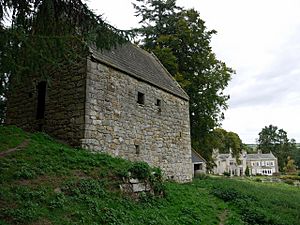Bastle house facts for kids

Bastle houses are special strong homes built a long time ago. You can find them along the border between England and Scotland. This area was once a dangerous place, with groups called border reivers often raiding farms. Bastle houses were designed like mini-forts to keep families and their animals safe from these attacks. The word "bastle" might come from the French word "bastille," which means a fortress.
Contents
What Makes a Bastle House Special?
Bastle houses have some very clear features that made them safe.
Strong Walls and Floors
- They have super thick stone walls. These walls are usually about 1 meter (3 feet) thick!
- The ground floor was used as a stable. This is where the most important farm animals, like cows or horses, would stay safe.
- Above the stable, there was a strong floor. This floor was often made of stone in a curved shape, like a vault, or sometimes flat wood.
Safe Living Space
- The family lived on the floor above the animals. This was the first floor.
- To get to the living area, people used a ladder or a simple stairway.
- At night, or when there was danger, the ladder could be pulled up. This made it very hard for raiders to get inside.
- The windows in bastle houses were very small. Some were even just narrow arrow slits. This helped keep out attackers.
Bastle Houses vs. Forts
Bastle houses share many features with military blockhouses. Blockhouses are small, strong forts. The main difference is that a bastle house was built mainly as a home for a family. A blockhouse was built only for defense.
Where Can You See Them Today?
Many bastle houses are still standing today. They were built so strongly that they have lasted a very long time. However, most of them are either in ruins or have been changed a lot. People now use them as homes or farm buildings. You can see these unique buildings on both sides of the English-Scottish border. Some good examples include Thropton Pele, Hole Bastle, Woodhouses Bastle, and Black Middens Bastle.


